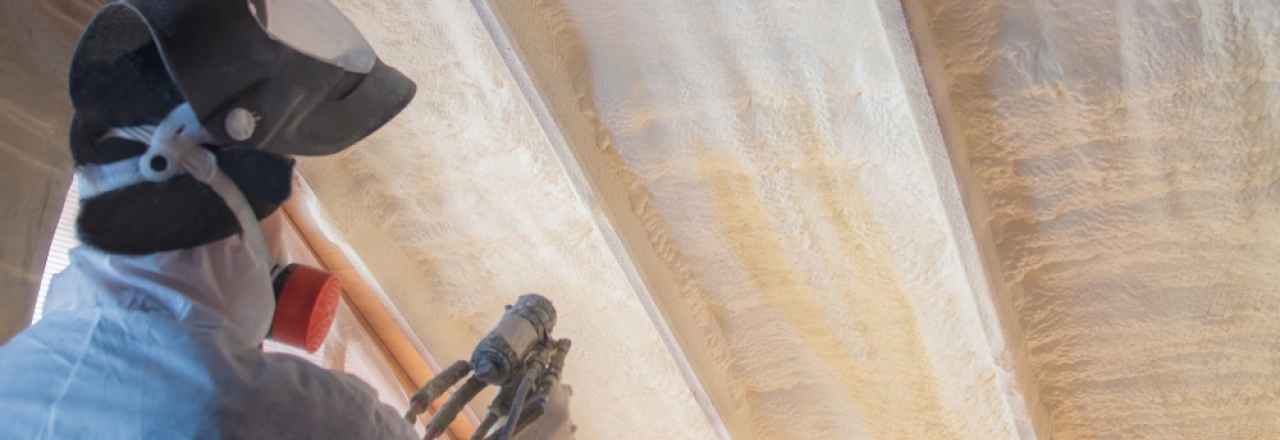
If you’re dealing with home comfort and moisture issues as well as high energy costs, you might be looking for insulation solutions that will work for your home design and climate.
If you’ve done any reading into properly protecting a home against moisture problems while also updating your insulation, you may know about vapor barriers (often confused with vapor retarders). But do you need to install a vapor barrier along with your new insulation? Does the answer change depending on what kind of insulation you use, or where in your house you’re having work done?
At Vermont Foam Insulation, we pride ourselves on expertly installing insulation using the latest in carbon-reducing and comfort-inducing building science techniques, which also aim to protect you and your home from moisture intrusion, indoor drafts, and high monthly bills. In this article, we’ll tackle this common question from homeowners.
Vapor Barrier vs. Vapor Retarder: What’s the Difference?
While these two terms are often confused, they are not exactly the same. The ability of a material to prevent water from permeating through its surface is rated in “perms”, with materials greater than 10 perms being considered vapor permeable, and materials less than 1 perm being considered vapor semi-permeable. Materials can also be further split into classes, with materials rated between 1 and 0.1 perms being classified as Class II, and anything less than 0.1 perms classified as Class I.
While the terms “retarder” and “barrier” are sometimes used interchangeably, a vapor retarder can generally be considered Class II and above, and vapor barriers are considered Class I.
Closed Cell Spray Foam Insulation Already Acts as a Powerful Vapor Retarder
One of the things that makes closed cell spray foam insulation one of the best insulation materials available is that it not only insulates, but is also an effective air barrier and vapor retarder as well. You could say that closed cell spray foam kills three birds with one stone. Interestingly, despite the importance of reducing vapor permeation, most moisture intrusion actually enters into a home’s walls or roof as a result of air leaks, and not water vapor diffusion. On average, 99% of moisture issues in walls or the roof of a home are the result of air leakage not permeation. However, this does not mean the other 1% doesn’t matter. To block the remaining 1%, in cold climates a vapor retarder will be required on the warm side of the insulation. Fortunately, closed cell spray foam, when sprayed in thicknesses of about 1.5” or thicker, acts as a vapor retarder. This makes closed cell spray foam an all-in-one solution for limiting heat transfer, air movement, AND moisture intrusion in the walls and roof of your house.
Installing an additional vapor barrier on above-ground walls that are insulated with spray foam is usually unnecessary. However, depending on the moisture levels and the design of your home, a traditional vapor barrier may still be utilized elsewhere—as “insurance.” For instance, covering any open earth dirt in a house with a plastic sheeting vapor barrier (Class I) is critical for lowering the relative humidity inside a home. This type of installation is common when retrofitting older homes that have dirt floors in the crawl space or basement.
The Areas of Your Home Where You May Need a Vapor Retarder
Some of the worst areas in a home for water and moisture problems are the basement and crawlspace, as well as the attic. Water and moisture can make their way in through cracks in your foundation or as the result of drainage issues around your house that allow rain and groundwater to find a way inside.
Maximize Your Spray Foam Installation Benefits By Starting with a Dry Home!
Spray foam vapor retarders and other vapor barriers are powerful tools for preventing moisture from getting into your walls and roof. But it’s essential to address any existing moisture issues inside your home before installing spray foam insulation. If you don’t, the same features of closed cell spray foam insulation that keep moisture out will also keep it in, and left unmitigated can create mold and rot in your house.
Even with superior spray foam basement and crawl space insulation, some basements require an additional crawl space encapsulation or wet basement waterproofing solution, like plastic vapor barriers, to keep moisture and humidity out. To deal with significant water issues in the bottom areas of a home, the experts at Vermont Foam Insulation offer a wide range of basement and crawl space services to address any situation we may find in your home. These solutions can include:
Crawl space and basement spray foam insulation installation
Dimple drainage matting
Dehumidifier installation
Vapor barrier installation
The Spray Foam Insulation Experts: Vermont Foam Insulation
Not sure how waterproof or airtight your home needs to be? Don’t worry—that’s what Vermont Foam Insulation is here for. We know how to correctly manage moisture and outside air infiltration, with years of experience installing spray foam in Vermont homes, as well as countless hours studying how water and heat move in and out of buildings.
Reach out today to talk to our team about a free site visit where we’ll take the time to conduct a thorough review and inspection of your home to identify the underlying causes of the problems you may be experiencing, whether it’s water and moisture issues, high energy bills, uneven indoor comfort, or all of the above!
Feel confident that the moisture issues in your house are being addressed for good. Call 802-231-4606 or contact us today and tell Vermont Foam Insulation more about the problems you’re facing in your home.
Is moisture wreaking havoc in your Vermont home?
Keep water out with our spray foam and vapor barrier solutions!
